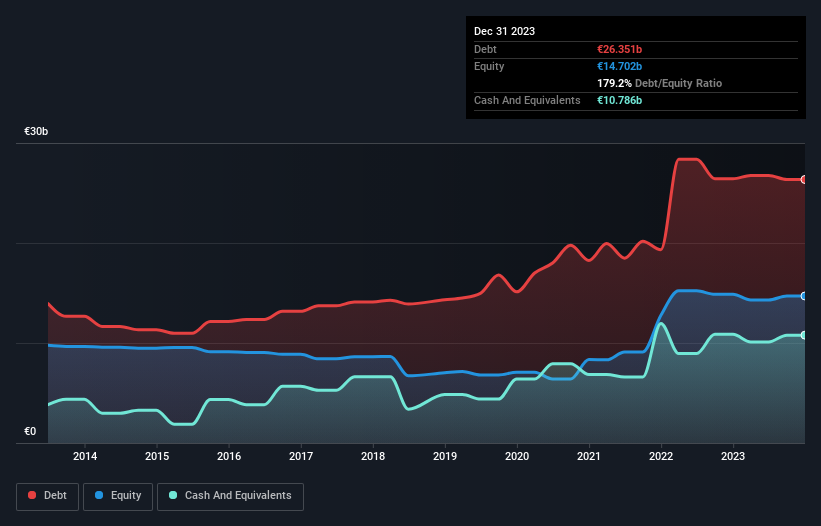
Warren Buffett famously said, 'Volatility is far from synonymous with risk.' It's only natural to consider a company's balance sheet when you examine how risky it is, since debt is often involved when a business collapses. We note that Veolia Environnement SA (EPA:VIE) does have debt on its balance sheet. But the more important question is: how much risk is that debt creating?
What Risk Does Debt Bring?
Debt and other liabilities become risky for a business when it cannot easily fulfill those obligations, either with free cash flow or by raising capital at an attractive price. In the worst case scenario, a company can go bankrupt if it cannot pay its creditors. However, a more common (but still painful) scenario is that it has to raise new equity capital at a low price, thus permanently diluting shareholders. Of course, plenty of companies use debt to fund growth, without any negative consequences. When we examine debt levels, we first consider both cash and debt levels, together.
View our latest analysis for Veolia Environnement
How Much Debt Does Veolia Environnement Carry?
The chart below, which you can click on for greater detail, shows that Veolia Environnement had €26.4b in debt in December 2023; about the same as the year before. However, it also had €10.8b in cash, and so its net debt is €15.6b.

A Look At Veolia Environnement's Liabilities
We can see from the most recent balance sheet that Veolia Environnement had liabilities of €30.0b falling due within a year, and liabilities of €27.9b due beyond that. Offsetting these obligations, it had cash of €10.8b as well as receivables valued at €14.7b due within 12 months. So its liabilities total €32.4b more than the combination of its cash and short-term receivables.
Given this deficit is actually higher than the company's massive market capitalization of €21.9b, we think shareholders really should watch Veolia Environnement's debt levels, like a parent watching their child ride a bike for the first time. Hypothetically, extremely heavy dilution would be required if the company were forced to pay down its liabilities by raising capital at the current share price.
We measure a company's debt load relative to its earnings power by looking at its net debt divided by its earnings before interest, tax, depreciation, and amortization (EBITDA) and by calculating how easily its earnings before interest and tax (EBIT) cover its interest expense (interest cover). Thus we consider debt relative to earnings both with and without depreciation and amortization expenses.
Veolia Environnement's debt is 2.9 times its EBITDA, and its EBIT cover its interest expense 3.7 times over. This suggests that while the debt levels are significant, we'd stop short of calling them problematic. On a slightly more positive note, Veolia Environnement grew its EBIT at 13% over the last year, further increasing its ability to manage debt. There's no doubt that we learn most about debt from the balance sheet. But it is future earnings, more than anything, that will determine Veolia Environnement's ability to maintain a healthy balance sheet going forward. So if you want to see what the professionals think, you might find this free report on analyst profit forecasts to be interesting.
But our final consideration is also important, because a company cannot pay debt with paper profits; it needs cold hard cash. So it's worth checking how much of that EBIT is backed by free cash flow. During the last three years, Veolia Environnement produced sturdy free cash flow equating to 69% of its EBIT, about what we'd expect. This free cash flow puts the company in a good position to pay down debt, when appropriate.
Our View
Veolia Environnement's struggle to handle its total liabilities had us second guessing its balance sheet strength, but the other data-points we considered were relatively redeeming. In particular, its conversion of EBIT to free cash flow was re-invigorating. We should also note that Integrated Utilities industry companies like Veolia Environnement commonly do use debt without problems. Taking the abovementioned factors together we do think Veolia Environnement's debt poses some risks to the business. While that debt can boost returns, we think the company has enough leverage now. When analysing debt levels, the balance sheet is the obvious place to start. But ultimately, every company can contain risks that exist outside of the balance sheet. We've identified 2 warning signs with Veolia Environnement (at least 1 which is significant) , and understanding them should be part of your investment process.
If, after all that, you're more interested in a fast growing company with a rock-solid balance sheet, then check out our list of net cash growth stocks without delay.
New: Manage All Your Stock Portfolios in One Place
We've created the ultimate portfolio companion for stock investors, and it's free.
• Connect an unlimited number of Portfolios and see your total in one currency
• Be alerted to new Warning Signs or Risks via email or mobile
• Track the Fair Value of your stocks
Have feedback on this article? Concerned about the content? Get in touch with us directly. Alternatively, email editorial-team (at) simplywallst.com.
This article by Simply Wall St is general in nature. We provide commentary based on historical data and analyst forecasts only using an unbiased methodology and our articles are not intended to be financial advice. It does not constitute a recommendation to buy or sell any stock, and does not take account of your objectives, or your financial situation. We aim to bring you long-term focused analysis driven by fundamental data. Note that our analysis may not factor in the latest price-sensitive company announcements or qualitative material. Simply Wall St has no position in any stocks mentioned.
About ENXTPA:VIE
Veolia Environnement
Designs and provides water, waste, and energy management solutions.
Proven track record average dividend payer.
Similar Companies
Market Insights
Community Narratives



